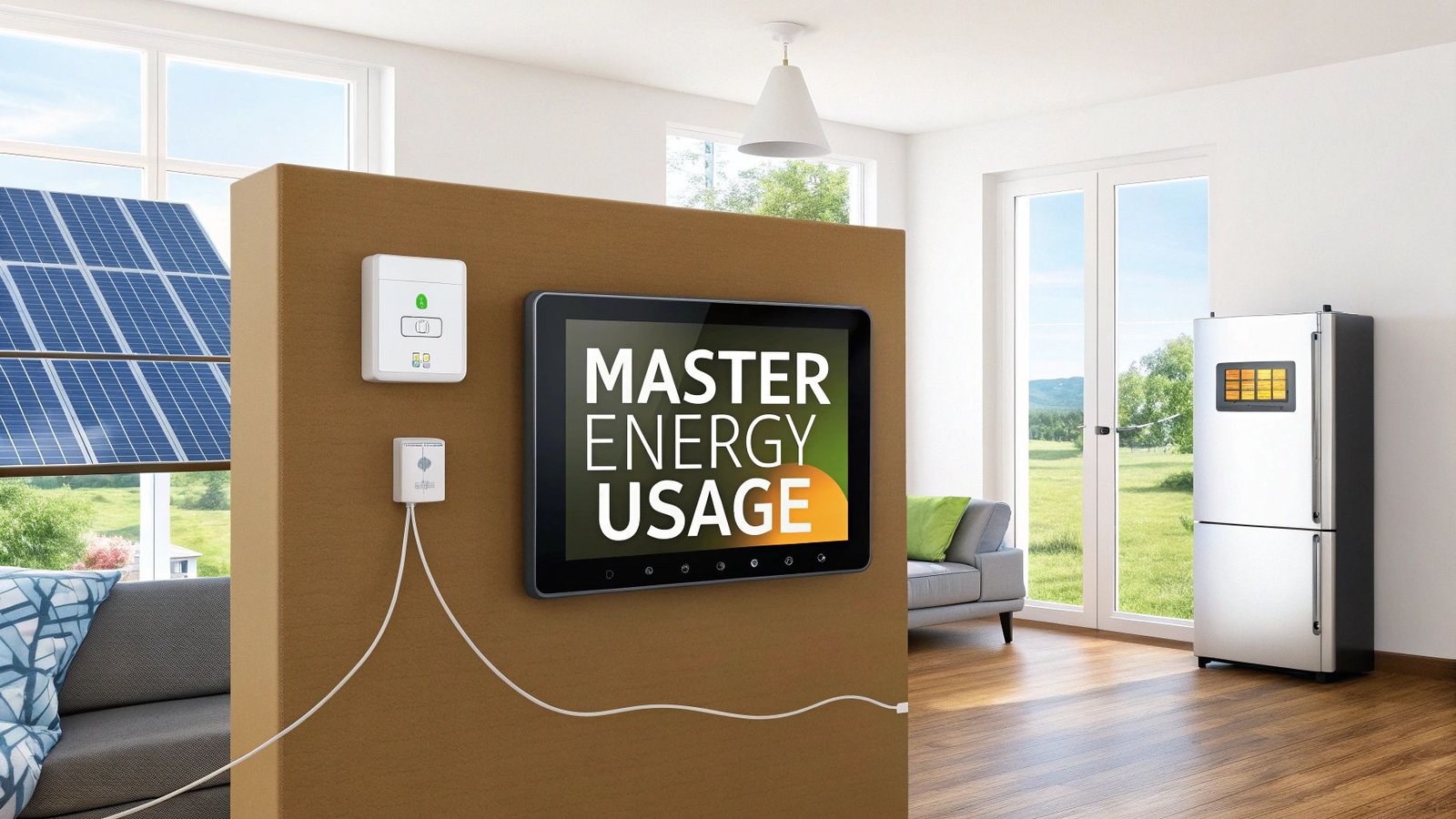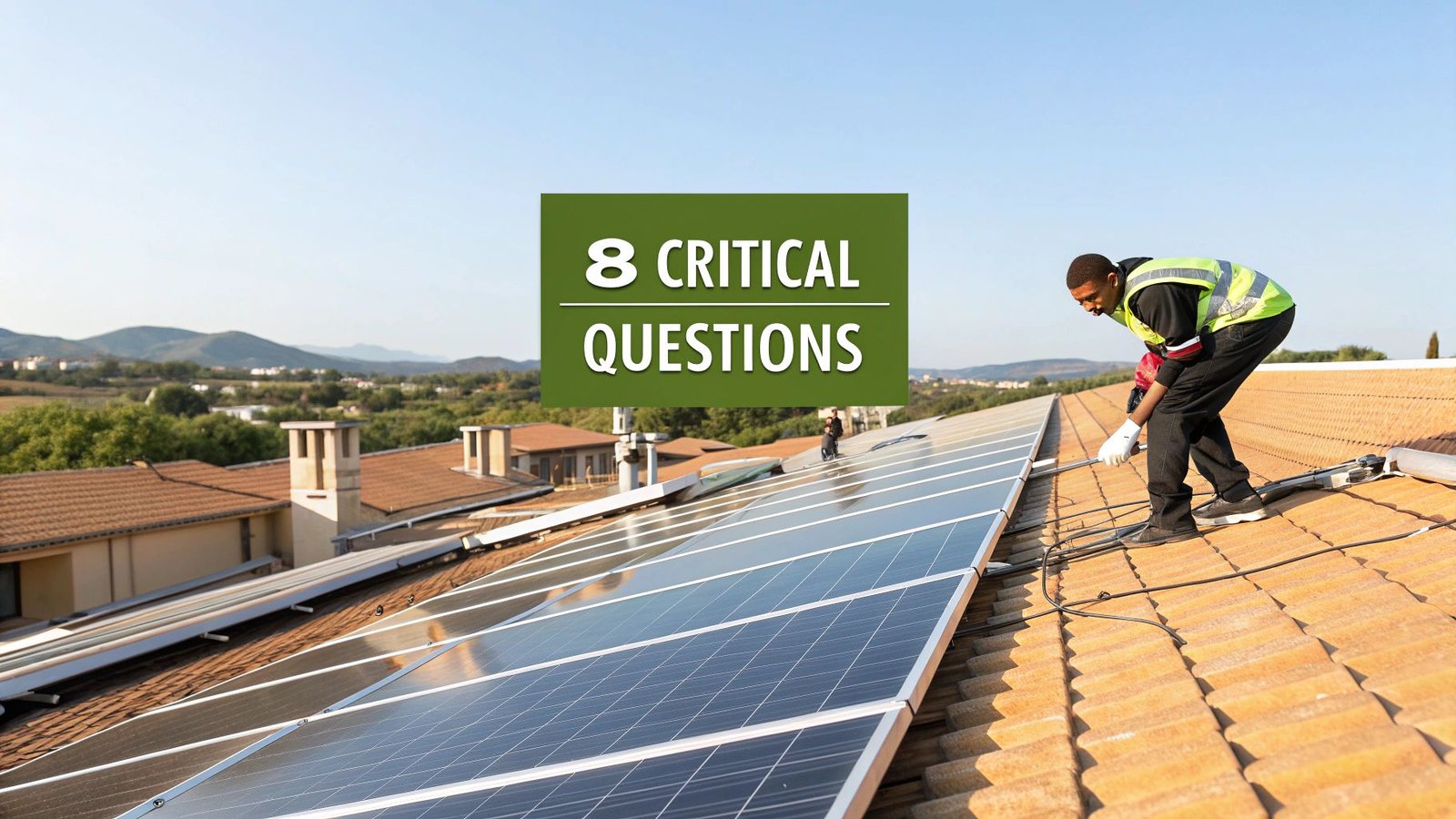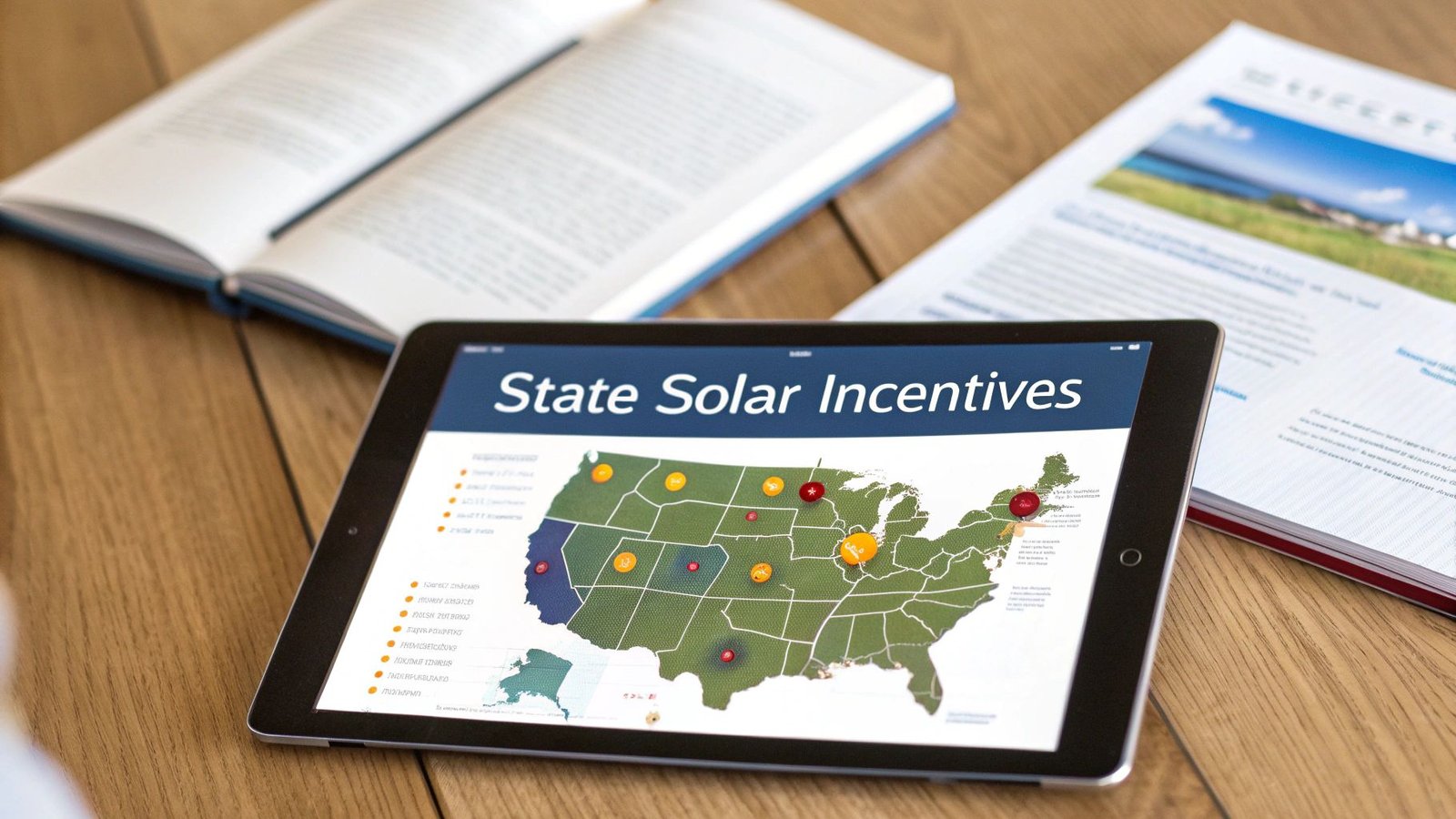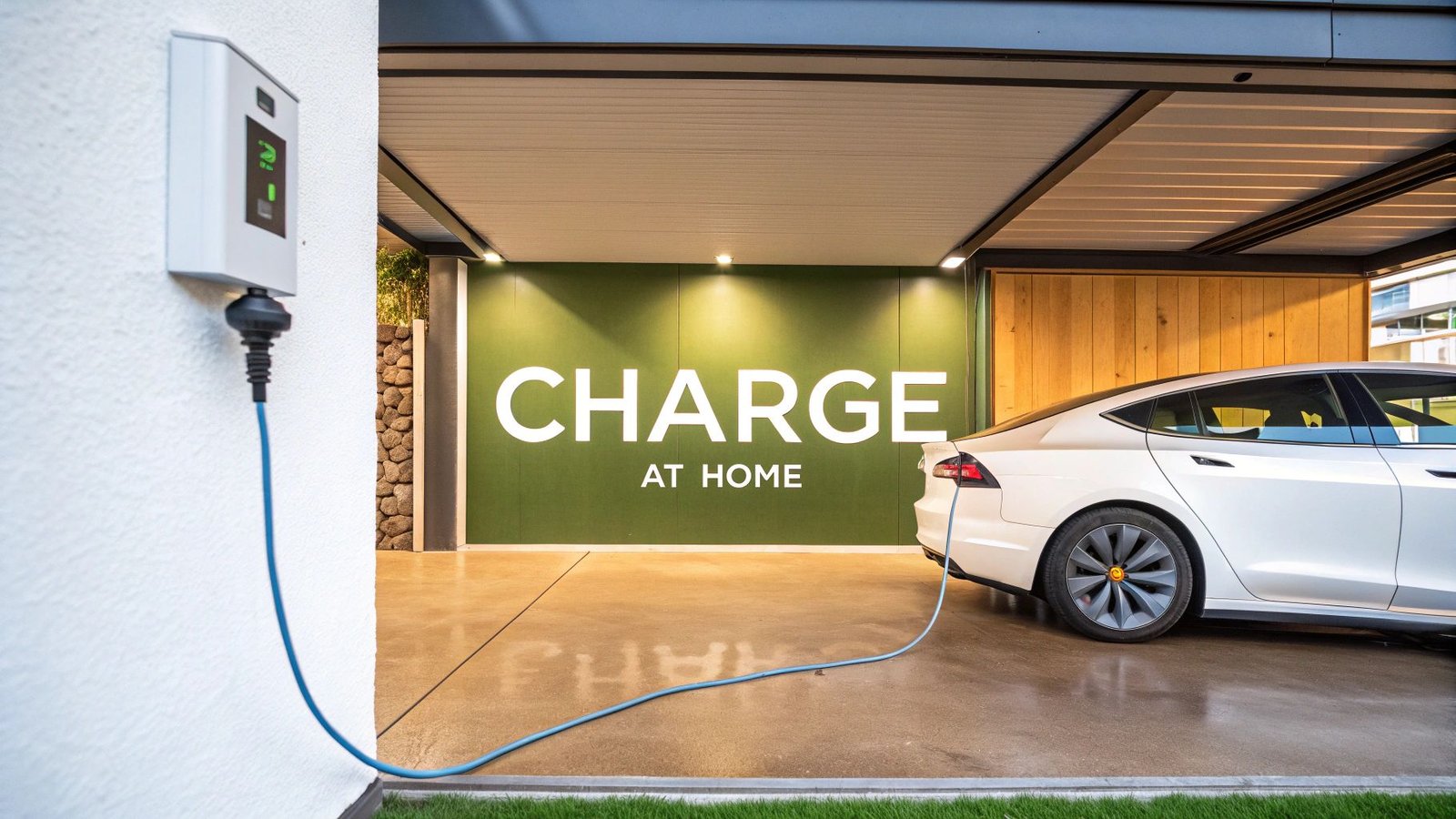Ever get that sinking feeling when you open a surprisingly high electricity bill? You're left wondering what on earth could have used so much power. What if you could see exactly where every dollar was going, in real time?
That's precisely what energy usage monitoring does. It's the practice of tracking and analyzing how much electricity your home consumes, giving you a clear window into your energy habits. Think of it less like a chore and more like a financial fitness tracker for your house. It gives you the hard data you need to get your home's energy health in shape.
Why Energy Usage Monitoring Is Your Secret Weapon
Knowing exactly what’s happening with your home's electricity use is powerful. This simple act of observation is the first and most critical step toward a smarter, more efficient home. By seeing the patterns—when you use the most power and which devices are the biggest culprits—you can start making targeted changes that lead to real savings.
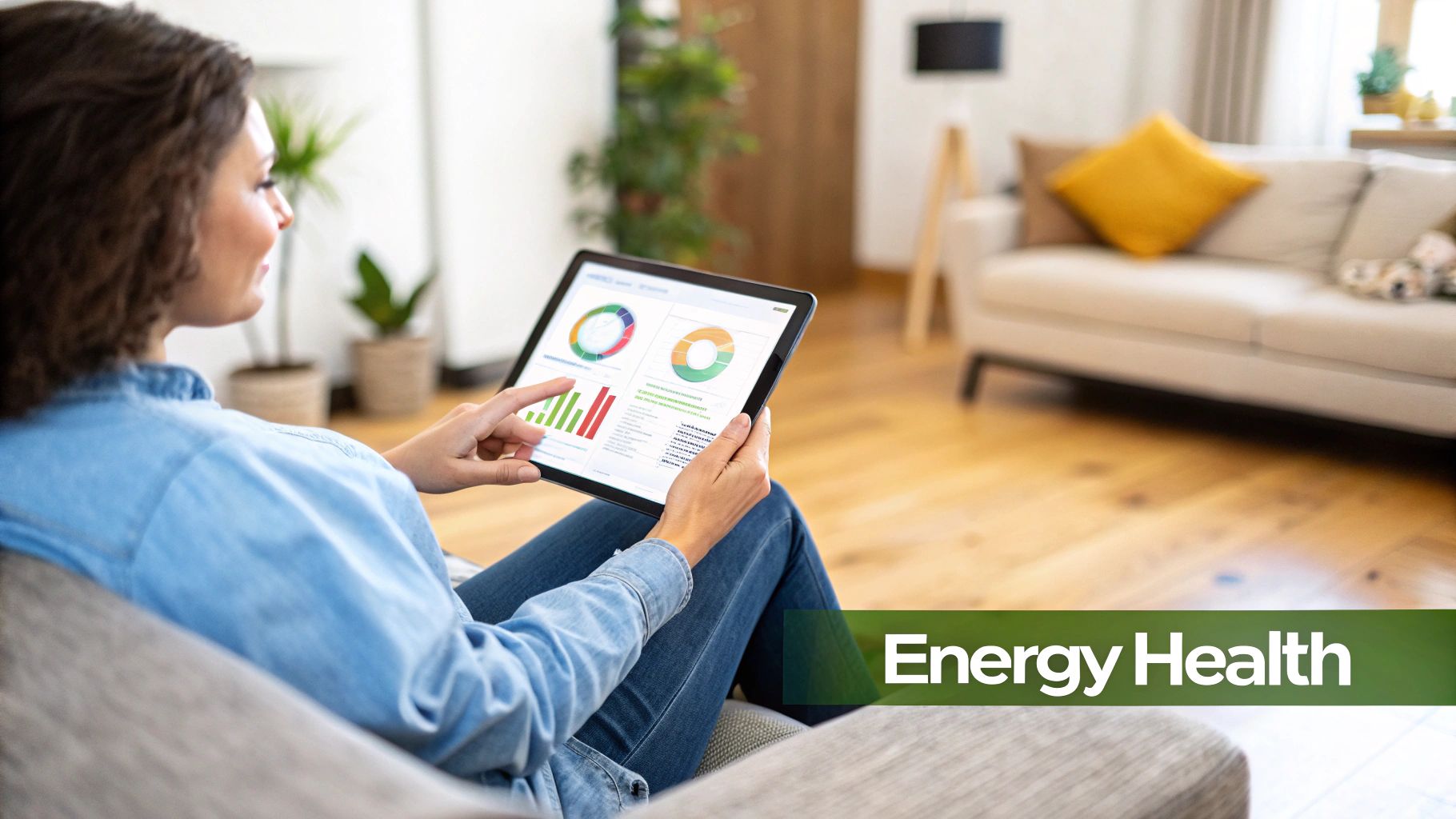
Without this data, you're just guessing. You might unplug a few lamps, but you're missing the big picture. Monitoring takes the guesswork out of the equation.
The Power of Knowing Your Numbers
Instead of wondering why your bill is so high, you can look at the data and see that the old, inefficient freezer in the garage is the real power hog. Or maybe you'll discover your HVAC system runs constantly during certain hours. This kind of knowledge is the foundation for taking effective action.
The core idea is simple yet powerful: You can't manage what you don't measure. Tracking your consumption turns abstract costs into tangible, actionable insights.
This insight is more important than ever. With global primary energy consumption hitting new highs—jumping by over 2% in the last year alone—taking control of our own household usage is a meaningful step. This isn't just about saving a few bucks; it's about being smarter in a world of rising demand.
Key Benefits of Monitoring Your Home's Energy Use
Putting an energy usage monitoring system in place gives you both immediate and long-term wins. The benefits go way beyond just saving money, helping you create a more sustainable and intelligently managed home. A great first step is to learn https://radiantenergysolar.com/how-to-calculate-energy-consumption/ to understand your baseline.
Here’s a quick look at what you stand to gain.
| Key Benefits of Monitoring Your Home's Energy Use |
| :— | :— |
| Benefit | Description |
| Cost Savings | Pinpoint and eliminate "phantom loads" from devices on standby and identify inefficient appliances, leading to direct cuts in your monthly bills. |
| Increased Awareness | Get a clear picture of your household's daily, weekly, and seasonal energy patterns so you can finally make informed choices. |
| Enhanced Efficiency | Fine-tune your big energy users, like your HVAC and water heater, based on real data, not just assumptions. |
| Environmental Impact | Shrink your carbon footprint by consciously using less power and contributing to a more sustainable lifestyle. |
At the end of the day, continuous monitoring is all about achieving greater energy efficiency. When you turn raw data into smart decisions, you're taking active control over both your home's performance and your budget.
How Energy Monitors Actually Work
Ever wonder how a small box can tell you exactly what your refrigerator is up to? Energy usage monitoring can seem a bit like magic, but the tech behind it is actually pretty clever and surprisingly down-to-earth. Think of these tools as interpreters, translating the invisible flow of electricity in your walls into numbers and graphs you can actually use.
Let's pull back the curtain and look at how these systems work, starting with the simplest gadgets and moving up to the most advanced setups for your home. Each step up the ladder gives you a clearer, more detailed picture of your energy habits.
Starting Small: Monitoring One Appliance at a Time
The most straightforward way to dip your toes into energy monitoring is with a plug-in monitor. It's basically a smart adapter that sits between your appliance and the wall outlet. You just plug the monitor into the wall, then plug your device—say, that old freezer in the garage or your entertainment center—into the monitor.
That’s it. The monitor measures every bit of electricity that flows through it to power that one specific appliance. This approach is fantastic for playing detective. If you have a hunch that a particular device is an energy hog, a plug-in monitor will give you the hard data to prove it, showing you exactly how many kilowatt-hours it’s guzzling over a day, a week, or a month.
The Big Picture: What Your Utility Company Sees
The next level is the smart meter, which your utility company has likely already installed on the side of your house. Unlike a plug-in monitor that zeroes in on a single device, a smart meter keeps an eye on the total electricity consumption for your entire property. It's the digital replacement for the old analog meter with the spinning dial, and it sends your usage data straight to the utility for billing.
While this gives you a great overview of your total consumption, it's a bit like looking at a forest without seeing the individual trees. You'll know you used a lot of power, but you won't know if the spike came from the AC kicking on or someone running the electric dryer.
A smart meter tells you that your energy use was high yesterday afternoon. A whole-home system tells you why—because your pool pump and HVAC system were running simultaneously for three hours.
Seeing Everything: The Power of Whole-Home Monitors
For the deepest, most actionable insights, whole-home clamp-on monitors are the way to go. These systems are like a heart-rate monitor for your home's electrical panel, giving you a complete, real-time readout of where your energy is flowing.
They work by using sensors called current transformers (CTs) that simply clamp around the main electrical wires in your breaker box. There's no complex rewiring involved; they safely measure the magnetic field generated by the electricity moving through the wires.
That information gets beamed to a hub that crunches the numbers and sends them to an app on your phone. Suddenly, you can see not just your total home usage, but what individual circuits are doing.
- Main Clamps: These bigger clamps go around the service mains entering your panel to measure the total power your home is drawing.
- Circuit Clamps: You can also place smaller clamps on individual breakers to track the big energy users, like your HVAC system, water heater, or EV charger.
This is where energy usage monitoring really shines. It’s no longer just about tracking numbers; it becomes a powerful diagnostic tool that shows you exactly where every watt is going, at any moment.
How to Choose the Right Energy Monitor for Your Home
With so many options out there, picking the right system for your energy usage monitoring can feel a bit overwhelming. But the secret isn't buried in technical specs—it’s about matching the monitor to what you actually want to accomplish. Think of this as your practical guide to finding the perfect fit.
The first question to ask yourself is simple: Are you a data nerd who wants to track every single watt, or are you just looking to find the biggest energy hogs in your house without any fuss? Your answer will point you directly to the right tool for the job.
This decision tree lays out a clear path to help you see which type of monitor aligns with your goals, whether you're targeting a single power-hungry appliance or analyzing your entire home.
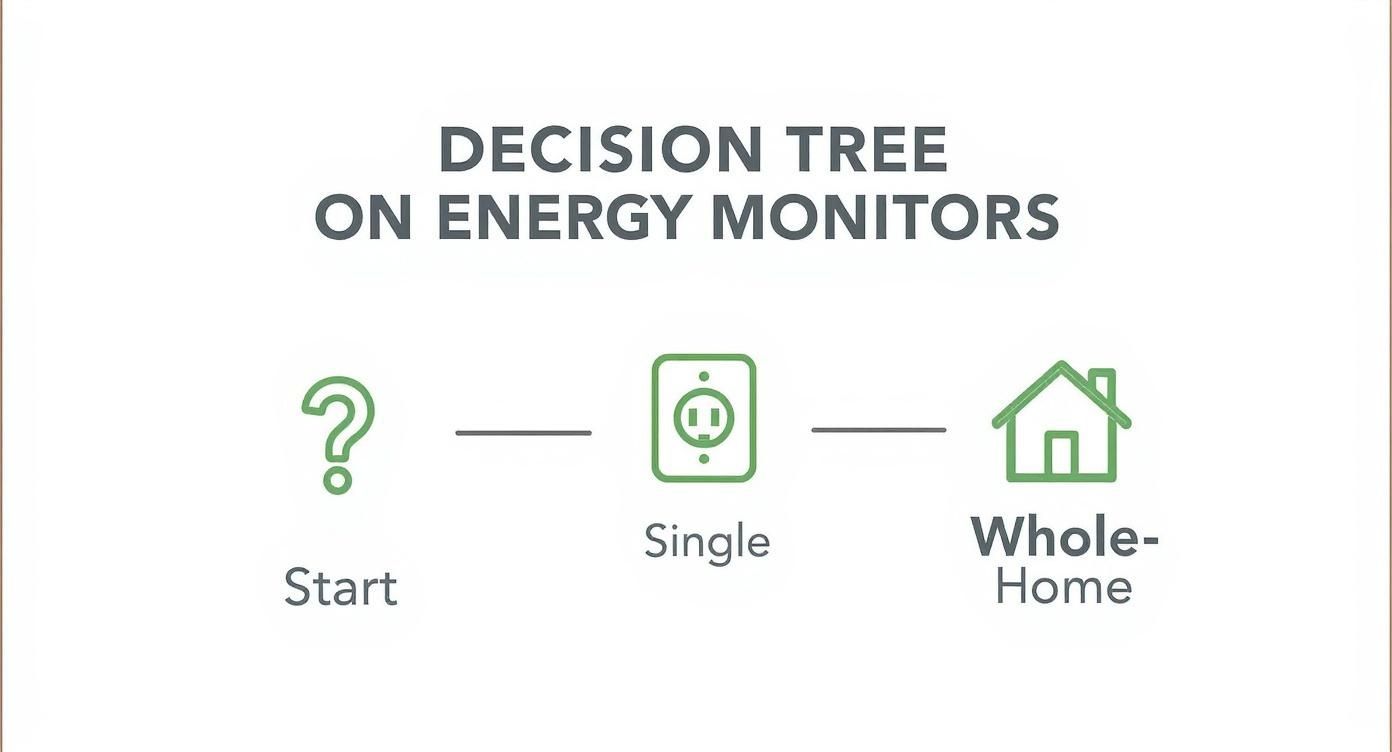
As you can see, the right technology really depends on what you're trying to figure out. A system designed for a whole-home overview is overkill if you're just curious about one specific device.
Comparing Your Monitoring Options
To make the choice even clearer, let's break down the main types of energy monitors. Each one strikes a different balance between detail, cost, and the effort required to get it up and running.
The best energy monitor isn't the most powerful one; it's the one you'll actually use. Aligning the system's capabilities with your lifestyle is crucial for long-term success.
This table gives you a side-by-side look at the most common systems, helping you weigh the factors that matter most to you.
Comparison of Energy Monitoring Systems
| System Type | Best For | Installation | Data Granularity | Typical Cost |
|---|---|---|---|---|
| Plug-in Monitor | Pinpointing a single suspicious appliance or device. | DIY: Simple plug-and-play. Takes seconds. | Appliance-Specific: Only measures the device plugged into it. | $15 – $40 |
| Smart Meter | Getting a general overview of your total household usage. | Professional: Installed and managed by your utility provider. | Whole-Home: Provides total consumption data, often with a delay. | Free (from utility) |
| Clamp-on Monitor | Detailed, real-time tracking of your entire home and key circuits. | DIY or Professional: Clamps onto wires in your breaker panel. | Circuit-Level: Can track individual circuits (HVAC, kitchen, etc.). | $150 – $400+ |
Ultimately, choosing the right system comes down to what you hope to achieve.
Making Your Final Decision
At the end of the day, your choice boils down to your personal goals for energy usage monitoring.
- For simple troubleshooting: If you think that old freezer in the garage is driving up your bill, a plug-in monitor is a cheap and incredibly effective way to find out for sure.
- For a general baseline: Your utility’s smart meter is a great, no-cost way to get a bird's-eye view and track your overall energy trends from month to month.
- For total home optimization: If you're serious about energy efficiency and want to see exactly when your AC kicks on or how much your EV charger is drawing in real time, a clamp-on monitor is the best investment you can make.
Once you know what you want to accomplish, you can confidently pick a system that empowers you to take control of your energy use and, most importantly, start saving money.
Optimizing Your Solar Panels and EV Charging
If you have solar panels or an electric vehicle, energy usage monitoring moves from a "nice-to-have" gadget to an absolute must. It's the brain of your modern home, turning it from a simple power consumer into a personal energy ecosystem you can fine-tune.
Think of it this way: without monitoring, you're flying blind. You can't be sure you're getting the most bang for your buck from your solar panels or charging your EV at the smartest, cheapest times. This level of insight is what makes your investment in green tech truly pay off.
Syncing Solar Production with Home Consumption
The best part of having solar is making your own clean power. But the real magic happens when you use that solar power the moment it's generated, instead of selling it back to the grid for pennies on the dollar. This is where a good monitoring system shines.
An integrated monitor lets you see your solar production and your home's energy use on one simple graph, all in real time. You instantly know when you're making more power than you're using.
graph TD
A[Sunny Day - 1 PM] --> B(Solar Production: 5.2 kW);
A --> C(Home Consumption: 1.8 kW);
B --> D{Surplus: 3.4 kW};
C --> D;
D --> E(Action: Charge EV);
D --> F(Action: Run Pool Pump);
This real-time feedback loop is the key to energy independence. It empowers you to shift your consumption—like running the dishwasher or pool pump midday—to align with peak solar production, maximizing your use of self-generated power.
This data helps you make smarter decisions. Maybe you'll notice a surplus of solar energy every sunny afternoon. That’s your cue! It's the perfect time to charge your EV or cool the house down before the evening rush, all with free energy from the sun. To go deeper, you can explore the specifics of what a complete solar monitoring system offers.
Smart Charging for Your Electric Vehicle
An EV is a big power draw, and when you charge it can make a massive difference in your monthly bill. Just plugging it in after work usually means you’re charging during the most expensive peak hours. Energy usage monitoring helps you sidestep that trap completely.
By tracking your EV charging sessions alongside your home's overall power use, you can:
- Identify Off-Peak Windows: Pinpoint the absolute cheapest hours to charge based on your utility’s time-of-use rates.
- Understand True Costs: See exactly how many kilowatt-hours your EV is pulling and what that adds to your bill.
- Balance with Solar: Time your charging to soak up any extra solar power you’re generating during the day.
While access to electricity has reached 92% worldwide, there are still gaps. This highlights just how important efficient management is, especially for off-grid solar solutions in developing communities. Careful monitoring ensures these systems are sustainable and cost-effective. You can learn more about these global energy trends over at Global Energy Monitor.
Bringing solar panels and an EV into your home is one thing; making them work together seamlessly is another. With the right data in your hands, you can create a highly efficient system that slashes your grid reliance and your energy costs.
Turning Energy Data into Real-World Savings
Collecting data is one thing, but the real magic happens when you use that information to make smarter, money-saving decisions. This is the moment your energy usage monitoring system stops being a neat gadget and becomes a serious financial tool. It’s all about translating those charts and numbers into a smaller utility bill.
Think of your energy data as a storybook of your home's daily life. The trick is learning how to read that story and find the expensive plot twists. With a good monitoring app, you can see exactly when your home is guzzling the most power, which helps you spot patterns and find opportunities to save.
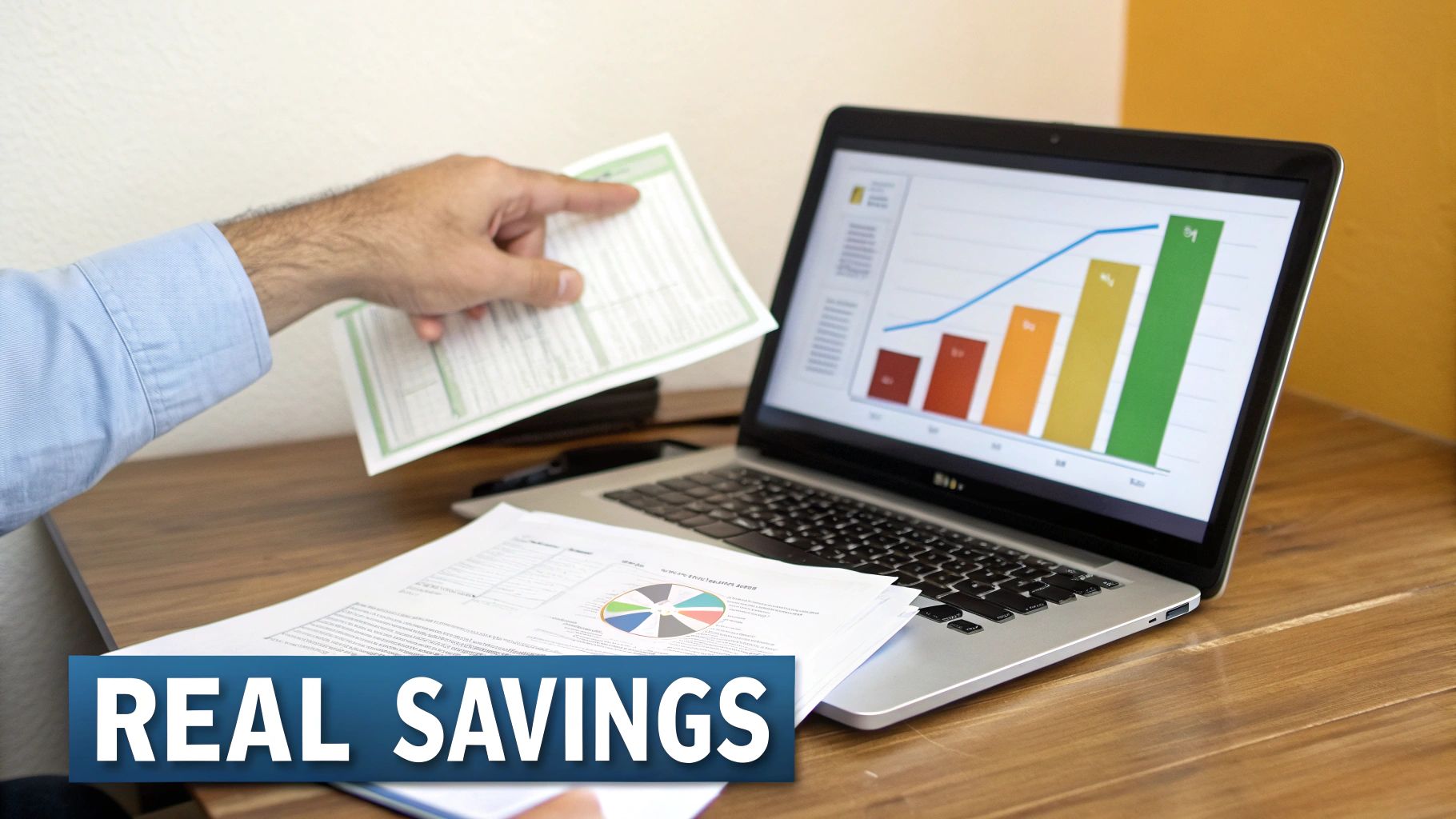
This kind of visual data makes it easy to see the obvious energy spikes, like the morning rush when everyone is getting ready. But its true power is in finding the hidden drains on your budget.
Uncovering Hidden Energy Hogs
One of the biggest culprits behind high energy bills is something called "phantom load," often nicknamed "vampire power." This is the electricity that your devices use even when they're turned off but still plugged in—think TVs, game consoles, and phone chargers. An energy monitor exposes this as a constant, low-level drain that runs all night long, when you’d think everything was off.
pie
title Typical Home Energy Consumption
"HVAC" : 45
"Water Heater" : 15
"Lighting" : 10
"Appliances" : 20
"Phantom Load" : 10
Spotting a consistent overnight phantom load of just 150 watts can lead to big savings. A homeowner could easily save over $150 per year just by plugging those devices into smart power strips that completely cut the power when they aren't in use.
Your HVAC system is another big one—it's likely the single largest energy user in your house. Monitoring data shows you exactly how often it's kicking on and off. If you see it cycling constantly on a mild day, that could be a red flag for poor insulation or an inefficient unit that needs a tune-up. While daily tweaks help, the biggest long-term savings often come from major upgrades; investing in Energy Star HVAC systems is a proven way to slash consumption for years to come.
From Analysis to Actionable Goals
Once you get a handle on your home's energy habits, you can start setting realistic goals to cut back. Here’s a simple way to get started:
- Establish a Baseline: Let your monitor run for a week to get a clear picture of your typical usage. This is your starting line.
- Identify Key Targets: Look at the data and find your top two or three energy hogs. Is it the old freezer in the garage? The HVAC?
- Set a Specific Goal: Aim for something achievable, like cutting your consumption by 10% in the first month. This could be as simple as adjusting your thermostat.
- Track Your Progress: Keep an eye on your monitor to see if the changes you're making are actually working.
This hands-on approach is more important than ever. If your utility company uses different pricing at different times of the day, understanding your own usage is key to avoiding those expensive peak hours. You can learn more about time-of-use electricity rates to build an even smarter savings strategy and stay ahead of rising costs.
Common Pitfalls in Energy Monitoring to Avoid
Getting started with energy usage monitoring is a great step, but a few common missteps can easily lead to frustration and inaccurate data. If you know what to look out for, you can sidestep these issues from the get-go and make sure you’re getting real value from your new system.
The Problem with Placement
One of the most common mistakes is simply incorrect sensor placement. If you’re using a clamp-on monitor, putting the sensor on the wrong wire—or even just facing it the wrong way—can throw your readings off completely.
This single error can make it seem like your home is consuming a tiny fraction of its actual power or, conversely, a massive amount. Either way, your data becomes useless. Always follow the installation manual to the letter, and when in doubt, call in a professional electrician.
Don't Sweat the Small Stuff
It’s surprisingly easy to get bogged down in the details, obsessing over every little watt. You might find yourself tracking the 5 watts your phone charger uses while completely missing the ancient, power-guzzling freezer running 24/7 in your basement. It’s a classic case of missing the forest for the trees.
Think of it this way: you wouldn't try to fill a leaky bucket by focusing on a single drop. Look for the biggest holes first. Use your monitor to pinpoint the top three energy hogs in your home and tackle those for the biggest, fastest impact on your bill.
Overcoming Data Overload
Another trap many people fall into is data fatigue. A constant stream of graphs, numbers, and alerts can quickly become overwhelming. Before you know it, you start tuning it all out, and the monitor you bought to help you save money starts collecting dust.
Your system should be a helpful tool, not a source of anxiety. To avoid burnout, set simple, achievable goals. Instead of watching the app like a hawk, check in once a day or focus on weekly trends. A simplified, targeted approach will help you stay engaged and turn those insights into real, long-term savings.
Frequently Asked Questions
It's natural to have a few questions when you first start looking into energy usage monitoring. Let's tackle some of the most common ones so you can feel confident about your next steps.
Can an Energy Monitor Really Save Me Money?
Absolutely, but it's not magic. Think of an energy monitor as a fitness tracker for your home's electricity use. The device itself doesn't save you money, but the information it gives you is what makes the difference.
By seeing exactly where your energy is going, you can make smarter decisions—like running the dishwasher when rates are lowest or finally pinpointing that old, inefficient freezer in the garage. Many homeowners who actively use the data find they can trim their electricity bills by a solid 10-15%.
Is It Difficult to Install a Whole-House Energy Monitor?
That really depends on the type of monitor you choose. The simplest ones are plug-in models, and they're as easy to set up as a new lamp. Just plug it in and you're good to go.
Whole-house monitors that use clamps are a bit more involved. These require you to open up your main electrical panel and place sensors around the main wires.
While many modern systems are designed for a DIY installation, your home's electrical panel is not the place for guesswork. If you have any hesitation or aren't completely comfortable working inside it, we strongly recommend hiring a licensed electrician. Safety always comes first.
How Accurate Are Home Energy Monitors?
You might be surprised. Most quality home energy monitors on the market today are highly accurate, typically landing within 1-2% of what your utility company’s official meter reads.
For the purpose of spotting energy hogs and tracking your usage habits, this level of precision is more than enough. While things like perfect sensor placement can influence the readings slightly, a good monitor will give you a clear, reliable picture of what's happening inside your home.
Ready to take control of your home's energy consumption? The experts at Radiant Energy can help you design and implement the perfect solar and monitoring solution to maximize your savings. Visit our website to get started.

